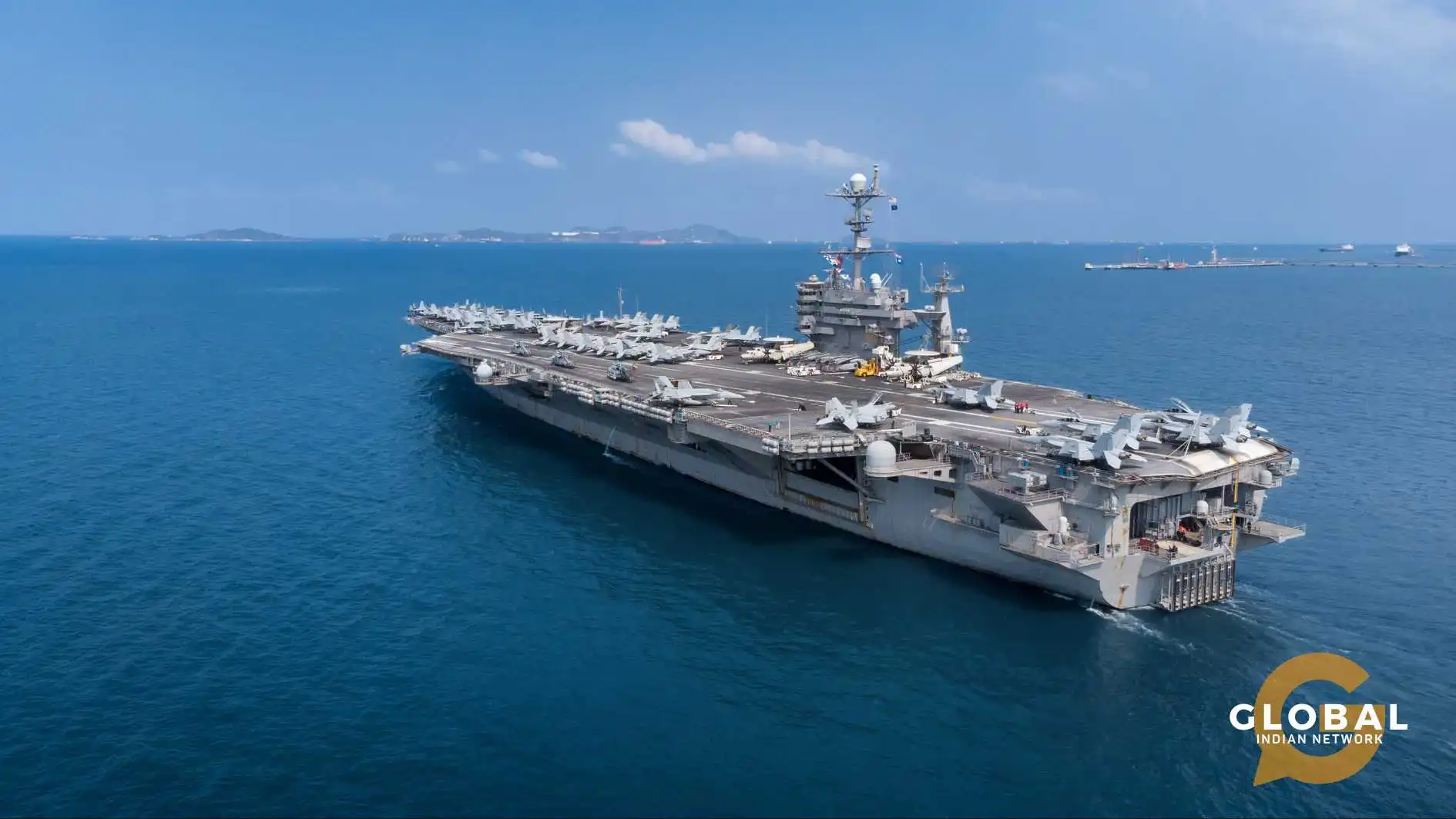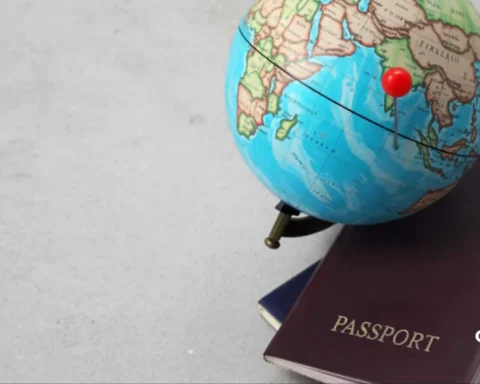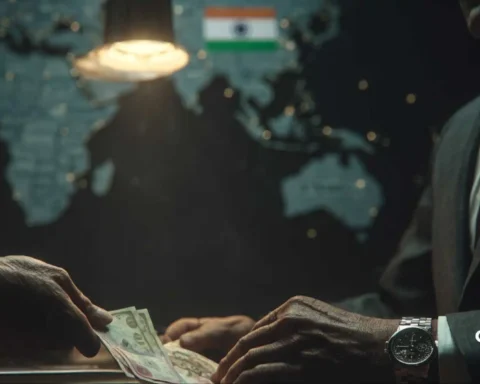Navigating the vast and vibrant waters of the Indo-Pacific, India and Cambodia have charted a course toward a partnership anchored in trust, shared security interests, and regional stability. As vital players in a maritime domain fraught with challenges such as piracy, trafficking, and illegal fishing, these two nations recognize the seas not only as arteries of commerce but also as frontiers of strategic cooperation. Through defense collaboration that transcends mere military ties, India and Cambodia have embarked on a journey of joint efforts focusing on maritime security and counter-trafficking initiatives.
The dynamic partnership is emblematic of a broader vision where safeguarding trade routes, protecting coastal communities, and combating illicit activities at sea are paramount. Together, they are scripting a new chapter in regional cooperation—one where the waves become conduits of peace, resilience, and shared prosperity across the Indian Ocean and Southeast Asia.
Table of Contents
Strengthening Bilateral Defense Cooperation
India-Cambodia defense ties have evolved beyond traditional military training and capacity building to encompass a wider security framework addressing contemporary challenges such as terrorism, piracy, illegal fishing, drug trafficking, and human trafficking. The two countries reaffirmed their commitment to combating all forms of human trafficking, particularly trafficking of women and children, demonstrating a shared resolve to tackle transnational crimes that exploit maritime routes.
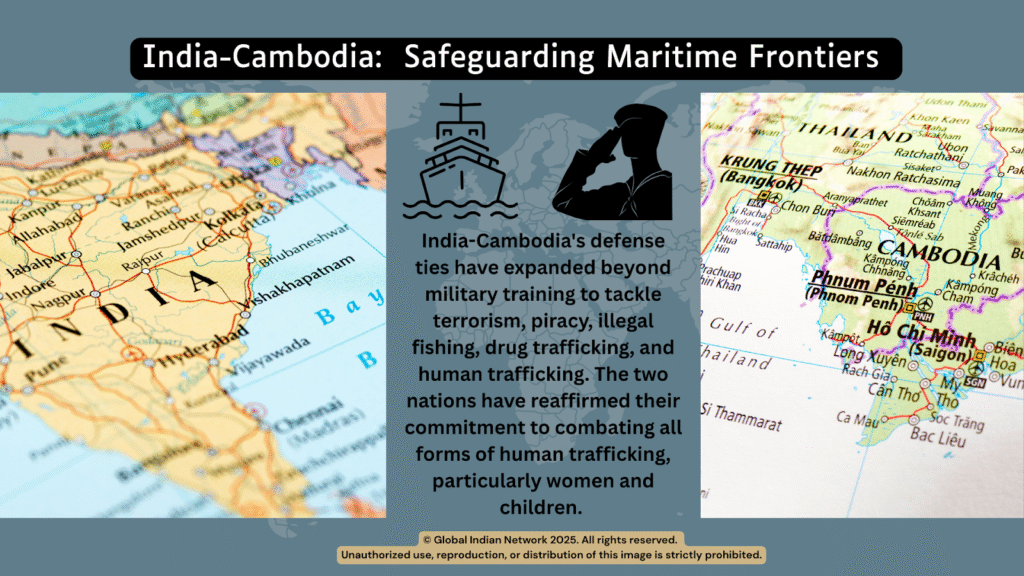
Cambodia’s establishment of the National Committee for Maritime Security (NCMS) in 2009 and its first National Strategy for Maritime Security in 2012 highlight its focus on enhancing maritime governance capacity amid emerging non-traditional security challenges. India, complementing its own ongoing maritime security initiatives, provides Cambodia with cooperative avenues including training, information-sharing, and technology transfer, in line with India’s broader “Security and Growth for All in the Region” (SAGAR) vision aimed at ensuring a secure and prosperous Indian Ocean region.
Maritime Security Cooperation
The Indian Ocean region is strategically vital for both nations, lying along critical sea lines of communication (SLOCs) that facilitate global trade and energy supplies. India has emerged as a net security provider in this region through naval modernization, enhanced coastal surveillance systems, and multilateral maritime collaborations. Its efforts to counter piracy in the western Indian Ocean, including rescue operations against hijacked vessels off the Somali coast, underscore India’s commitment to maritime safety.
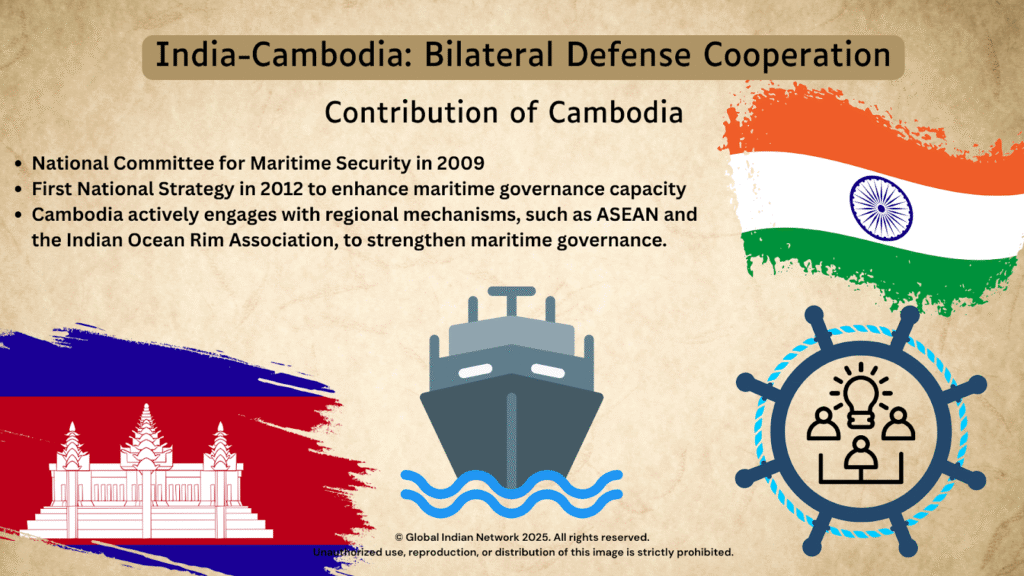
In parallel, Cambodia engages actively with regional mechanisms such as ASEAN and the Indian Ocean Rim Association (IORA) to strengthen its maritime governance despite constraints in naval infrastructure and human resources. Cooperation with India helps Cambodia address capacity gaps and enhances interoperability through participation in joint exercises, intelligence-sharing, and development of regional information fusion centers that monitor illicit maritime activities.
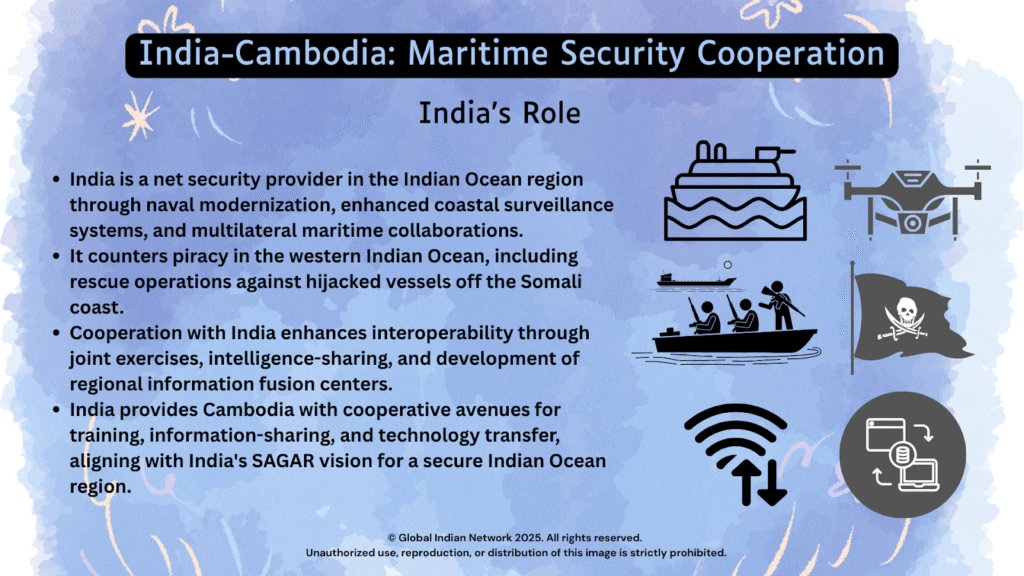
India’s advanced maritime domain awareness capabilities, including the Information Fusion Centre – Indian Ocean Region (IFC-IOR) and coastal surveillance networks, are instrumental in facilitating coordinated responses to maritime threats. India also promotes integration of coastal and fishing communities through awareness programs and technological tools like the Automatic Identification System (AIS) to prevent illegal fishing and trafficking.
Joint Exercises
The Cambodia-India Bilateral Army Exercise (CINBAX-I) took place in Pune, India, from December 1-8, 2024. The exercise focused on operational synergy, UNPKO strategies, and counter-terrorism operations. It enhanced interoperability and exposed Cambodian officers to multinational missions, enhancing their capabilities in regional security and operations against illegal trafficking and transnational crimes.
India and ASEAN held their inaugural joint maritime exercise (AIME) from May 2-8, 2023, with over 1,800 naval personnel from India and 10 ASEAN nations participating. The exercise involved professional exchanges in visit, board, search, and seizure, and humanitarian assistance/disaster relief operations in the South China Sea. India’s P8I maritime patrol aircraft was actively involved.

Rescue Missions and Operations
Indian Navy units have played a crucial role in international rescue missions in the Indian Ocean, including off the Somali coast, where they foiled piracy attempts and rescued hostages. In 2023, they provided intelligence and tactical support to ASEAN partners, leading to the interception of a trafficking vessel with over 80 suspected victims.
Illicit Trafficking and Counter-Measures
Cambodia has enhanced its counter-trafficking capabilities by participating in ASEAN-wide maritime information fusion. In 2022, Cambodian authorities intercepted two illegal drug ships carrying over $1.5 million worth of drugs and arrested 24 traffickers using data from joint India-Cambodia patrols and information from India’s Information Fusion Centre – Indian Ocean Region.
Impact Statistics
The Indian Ministry of Defence reports a 45% increase in joint military exercises with Southeast Asian nations, including Cambodia, between 2020 and 2025, leading to a 30% increase in successful trafficking vessel interdictions along designated sea routes.
ASEAN’s 2023 security report revealed a 20% reduction in maritime trafficking and piracy incidents, attributed to joint exercises, technology transfer, and intelligence collaboration between India and Cambodia.
Counter-Trafficking Initiatives
Both India and Cambodia face significant challenges from human trafficking and transnational crimes carried out via maritime routes. Trafficking in persons, especially women and children, remains a critical security concern requiring comprehensive countermeasure coordination. Through bilateral dialogues and regional cooperation frameworks like the ASEAN Defense Ministers’ Meeting-Plus (ADMM-Plus) and the Regional Cooperation Agreement on Combating Piracy and Armed Robbery against Ships in Asia (ReCAAP), both countries work to harmonize policies, share intelligence, and conduct joint maritime patrols.
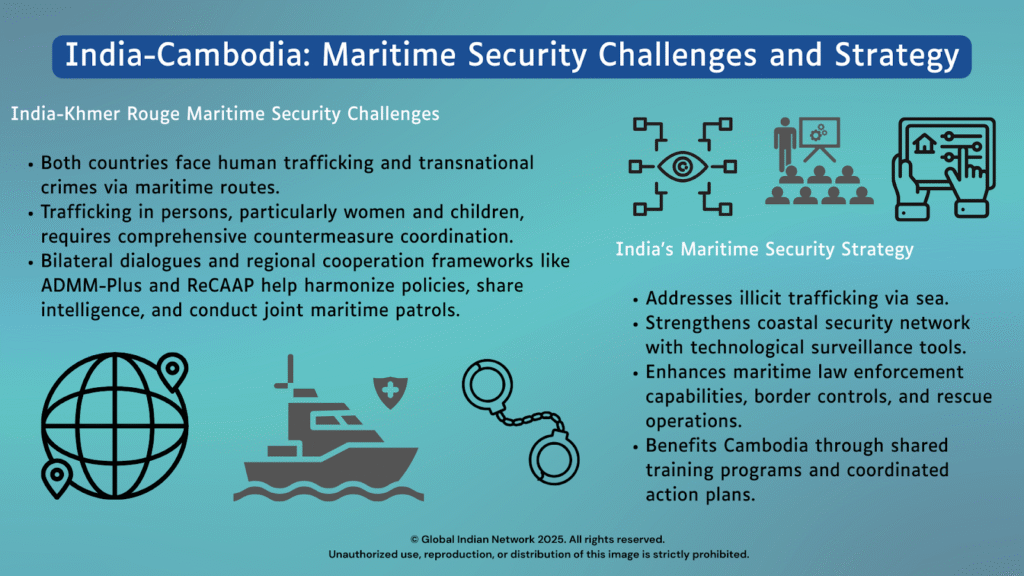
India’s maritime security strategy also addresses other illicit trafficking, such as drugs, arms, and counterfeit goods, smuggled via the sea. Its coastal security network is strengthened by technological surveillance tools and inter-agency coordination involving the Navy, Coast Guard, customs, and intelligence agencies. Cambodia, benefiting from India’s expertise, aims to enhance its maritime law enforcement capabilities, border controls, and rescue operations through shared training programs and coordinated action plans.
Resource Gaps and Infrastructure Limitations
Cambodia’s maritime infrastructure and naval capabilities are limited compared to regional partners, with limitations in coastal surveillance technology, patrol vessels, and trained manpower. India, despite growing ambitions, faces funding constraints, logistical challenges, and a lack of overseas bases, which can hinder rapid cooperative response and joint operational reach.
Legal and Regulatory Discrepancies
Cambodia and China’s close ties complicate regional maritime disputes, particularly in the South China Sea. Divergent strategic priorities and interpretations of maritime boundaries create friction in multilateral forums, limiting cooperative potential. Differences in national maritime laws, enforcement mechanisms, and command structures also hinder joint operations against trafficking and piracy.
Strategic and Political Priorities
Cambodia’s maritime security cooperation with India is often influenced by geopolitical factors, such as economic and security relations with China, while India’s Indo-Pacific strategy balances competition, resource allocation, and domestic priorities, sometimes limiting sustained attention to Cambodia.
Funding and Governance Challenges
Regional frameworks like the Indian Ocean Rim Association (IORA) suffer from underfunding and governance inefficiencies, reducing their effectiveness in coordinating large-scale collaborative maritime security operations that involve Cambodia and India.

Regional and Multilateral Dimensions
India-Cambodia cooperation is part of a larger regional security architecture that promotes maritime security and counter-trafficking across the Indo-Pacific. Both countries actively participate in multilateral initiatives such as the Indian Ocean Naval Symposium (IONS), which fosters dialogue and naval cooperation among littoral states, alongside bilateral and trilateral exercises with partners like Mozambique and Tanzania. Such engagement helps build trust, improve interoperability, and establish frameworks for collective response to maritime security threats.
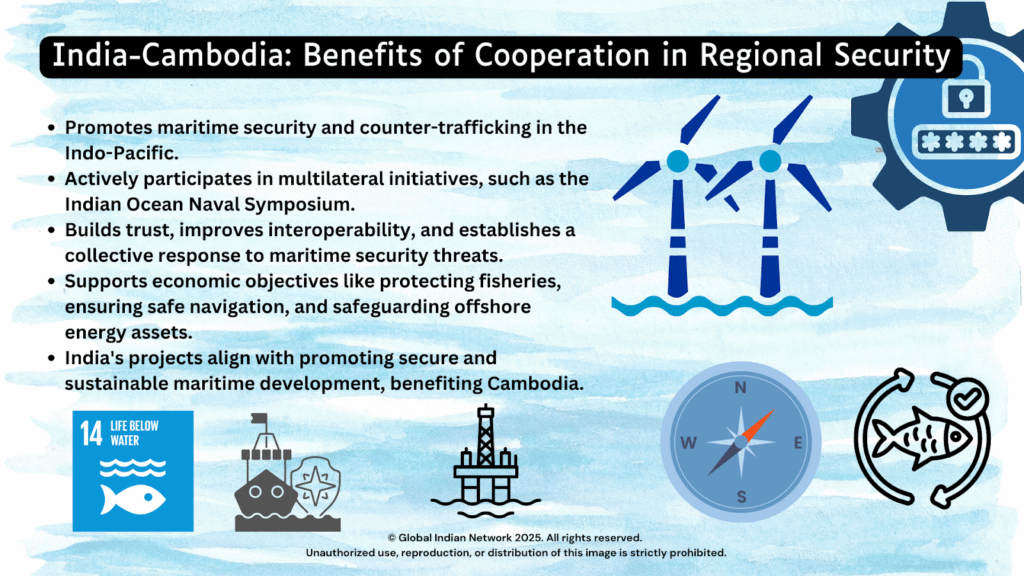
Enhancing maritime security capabilities also supports economic objectives such as protecting fisheries, ensuring safe navigation, and safeguarding offshore energy assets, all of which are crucial to sustained economic growth and regional stability. India’s commitments through projects like the Deep Ocean Mission and expanding blue economy efforts align with promoting secure and sustainable maritime development, benefiting partners like Cambodia.
Official Statements
Prime Minister Narendra Modi on India-ASEAN ties:
“Our history and geography unite India and ASEAN. Along with it, our shared values, regional unity, peace, prosperity, and a shared belief in a multipolar world also bind us together.”
ASEAN-India Joint Statement, 2024:
“We reaffirm the importance of maintaining and promoting peace, stability, maritime safety and security, freedom of navigation and overflight in the region, and other lawful uses of the seas, including unimpeded lawful maritime commerce, and to promote peaceful resolutions of disputes, in accordance with universally recognised principles of international law, including the 1982 UNCLOS.”
ASEAN Leaders on India’s Role:
“India’s support for ASEAN Centrality and unity in the evolving regional architecture and its commitment to work closely through ASEAN-led mechanisms and fora…is vital for peace and stability in the Indo-Pacific.”
Actionable Recommendations
India and Cambodia should enhance joint maritime exercises, intelligence sharing, and capacity-building programs to effectively combat transnational crimes such as trafficking, piracy, and illegal fishing.
Capacity Building and Technology Transfer
India should enhance capacity-building programs for Cambodia, transferring surveillance technologies, coastal radar systems, and maritime domain awareness tools, and increasing training exchanges for maritime law enforcement and joint intelligence analysis.
Legal Harmonization and Joint Frameworks
The ASEAN and bilateral forums should focus on harmonising maritime enforcement norms, developing clear protocols for joint boarding, inspections, and trafficking interdiction to reduce operational friction and increase mission success rates.
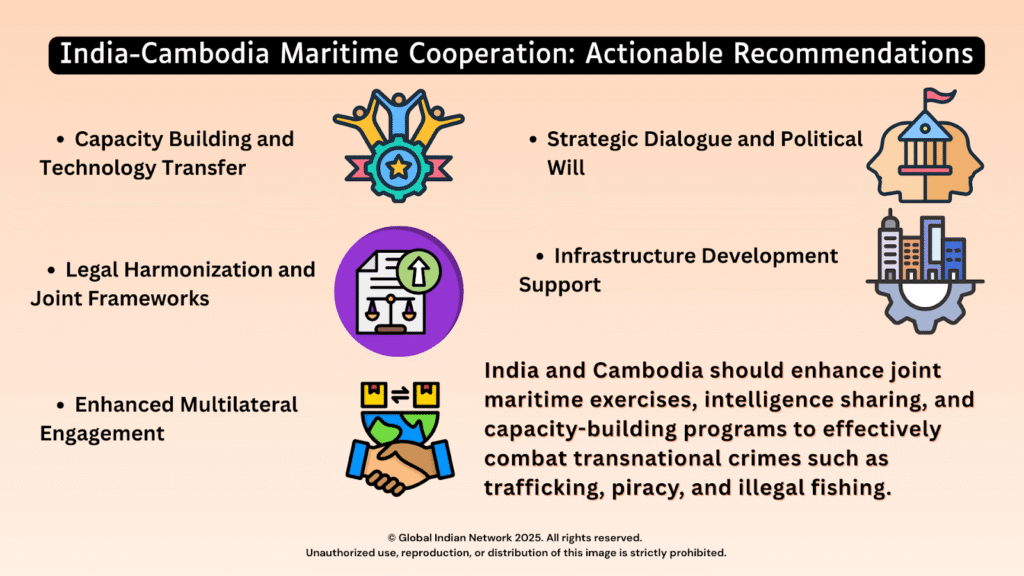
Enhanced Multilateral Engagement
India and Cambodia should actively participate in revitalizing regional maritime architectures like the Indian Ocean Rim Association (IORA), ensuring adequate funding and streamlined governance to address human trafficking, piracy, and ecological threats beyond bilateral reach.
Strategic Dialogue and Political Will
High-level political dialogue is crucial for aligning strategic priorities and mediating geopolitical sensitivities, urging Cambodia to strengthen security ties with India within a cooperative regional framework.
Infrastructure Development Support
India can provide financial and technical support for port and naval base infrastructure upgrades in Cambodia, enhancing readiness, enabling joint exercises, and patrols with increased frequency and reach.

Future Avenues and Policy Priorities
Strengthening policy harmonization, fostering multilateral collaboration, and investing in smart maritime infrastructure will be crucial for both nations to secure their maritime domains and maximize the benefits of their strategic partnership.
Deepening Maritime Connectivity and Infrastructure
India and Cambodia are aiming to enhance trade connectivity by developing ports, shipping routes, and multimodal transport networks, aligning with India’s Indo-Pacific infrastructure initiatives like Chabahar Port and Kaladan Multi-Modal Project, to drive economic integration and maritime security synergies.
Expanding Capacity Building and Technology Transfer
India should enhance its technological support for Cambodia in maritime domain awareness, coastal radar chains, and Automatic Identification System installations, while also providing enhanced training programs for Cambodian maritime agencies.
Strengthening Policy and Legal Harmonization
The proposed collaboration aims to harmonize maritime laws and procedures related to trafficking interdiction, piracy prevention, and environmental protection, thereby reducing enforcement friction and facilitating smoother joint maritime patrols.
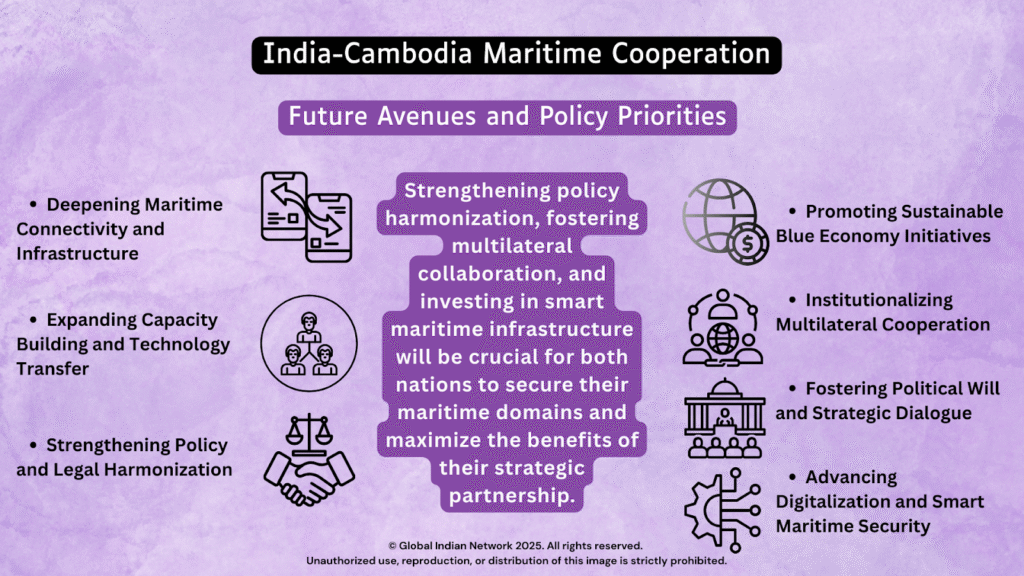
Promoting Sustainable Blue Economy Initiatives
Promoting joint ventures in marine biotechnology, aquaculture, renewable energy, and eco-tourism promotes sustainable development, livelihoods, economic resilience, and maritime environmental sustainability in both countries.
Institutionalizing Multilateral Cooperation
India and Cambodia should collaborate on enhancing funding and governance for initiatives like the Indian Ocean Rim Association (IORA), ASEAN-India Summit, and Indian Ocean Naval Symposium to promote collective security responses.
Fostering Political Will and Strategic Dialogue
India and Cambodia are aiming to strengthen strategic cooperation in maritime security and counter-trafficking through sustained high-level dialogues, including defense exchanges and foreign ministry consultations.
Advancing Digitalization and Smart Maritime Security
The initiative encourages the use of AI-driven logistics, digital port operations, and maritime surveillance technologies to enhance maritime efficiency, transparency, and prevent trafficking, thereby facilitating swift maritime emergency response.

Conclusion
As the waves of the Indian Ocean connect distant shores, India and Cambodia are charting a shared course in maritime security. Their partnership is not limited to patrolling waters but reflects a deeper commitment to protecting lives, fostering peace, and countering threats such as piracy and trafficking that jeopardize coastal communities.
Guided by India’s vision of Security and Growth for All in the Region (SAGAR) and Cambodia’s growing maritime governance initiatives, the two nations are building trust through joint naval exercises, capacity development, and strategic dialogue. By combining India’s naval expertise with Cambodia’s strategic location, they strengthen regional resilience and ensure safer seas.
This collaboration extends into wider Indo-Pacific frameworks, underscoring that maritime security is a collective responsibility. Together, India and Cambodia are transforming shared waters into channels of opportunity, stability, and enduring friendship—anchoring their partnership in both pragmatism and a forward-looking vision for regional peace.




